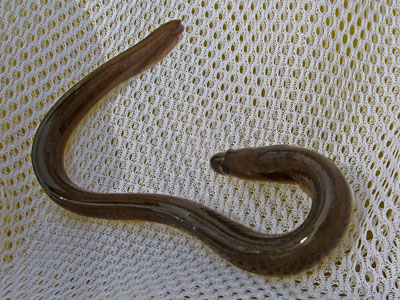
American eels and other migratory fish are returning to the upper Patapsco River following a series of dam removals.
Every year scientists from the Maryland Department of Natural Resources (DNR) perform field work as part of the Maryland Biological Stream Survey (MBSS).
Information from surveys is used to develop a Fish Index of Biotic Integrity that can show whether a stream is biologically healthy or not.
One of the survey sites, just upstream from the Bloede Dam removal site, is providing clues about eel movements in the watershed. The number of eels navigating the eel ladder on the remaining Daniels Dam has increased exponentially since Bloede Dam’s removal, according to scientists.
DNR staff counted 361 eels in 2020; 3,000 in 2021; and 36,000 in 2022. By mid-October 2023, DNR staff had counted more than 30,000 eels navigating the ladder.
American eels live in the river but migrate to the Sargasso Sea in the Atlantic Ocean to spawn and are an important food source for large fish and birds.
Surveys in the Patapsco watershed also find smallmouth bass, redbreast sunfish, white suckers, northern hogsuckers, swallowtail shiners, and other species.
As part of the Maryland Biological Stream Survey, DNR scientists often survey sites where environmental restoration, dam removals, or other projects are taking place to evaluate how that work is affecting the health of the stream.
DNR scientists have been evaluating stream health throughout Maryland since 1995. They sample about 200 streams per year for macroinvertebrates, fish, and environmental factors such as habitat and water chemistry.
The Bloede Dam removal and river restoration project was completed in 2019. The project was part of a decades-long restoration effort that included the removal of Simkins Dam and Union Dam.
Removal of Bloede Dam restored to the river and its tributaries more than 65 miles of spawning habitat for blueback herring, alewife, American shad, and hickory shad in the watershed, and more than 183 miles for American eel.
source: Maryland Department of Natural Resources
Leave a Reply
You must be logged in to post a comment.